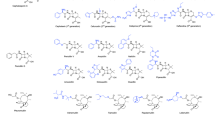Abstract
This work investigated the biodegradation capabilitiesof indigenous microorganisms exposed to differentcombinations of aromatic hydrocarbons. Considerablediversity was found in the catabolic specificity of 55strains. Toluene was the most commonly degradedcompound, followed by p-xylene, m-xyleneand ethylbenzene. Strains capable of degradingo-xylene and benzene, which were theleast-frequently-degraded compounds, exhibited broaderbiodegradation capabilities. Kappa statistics showeda significant correlation between the abilities todegrade toluene and ethylbenzene, p-xylene andm-xylene, and p-xylene and o-xylene. The ability to degrade naphthalene was correlated tothe ability to degrade other alkylbenzenes, but notbenzene. In addition, the inability to degradebenzene was correlated to the inability to degradeo-xylene. Factorial analysis of variance showedthat biodegradation capabilities were generallybroader when aromatic hydrocarbons were fed asmixtures than when fed separately. Beneficialsubstrate interactions included enhanced degradationof benzene, p-xylene, and naphthalene whentoluene was present, and enhanced degradation ofnaphthalene by ethylbenzene. Such heuristicrelationships may be useful to predict biodegradationpatterns when bacteria are exposed to differentaromatic hydrocarbon mixtures.
Similar content being viewed by others
References
Alvarez PJJ & Vogel TM (1991) Substrate interactions of benzene, toluene, and para-xylene during microbial degradation by pure cultures and mixed culture aquifer slurries. Appl. Environ. Microbiol. 57: 2981–2985.
Alvarez PJJ & Vogel TM (1995) Degradation of BTEX and their aerobic metabolites by indigenous aquifer microorganisms under nitrate reducing conditions. Wat. Sci. Tech. 31: 15–28.
Arvin E, Jensen BK & Gundersen AT (1989) Substrate interactions during aerobic biodegradation of benzene. Appl. Environ. Microbiol. 55: 3221–3225.
Chang MK, Voice TC & Criddle CS (1993) Kinetics of competitive inhibition and cometabolism in the biodegradation of benzene, toluene, and p-xylene by two Pseudomonas isolates. Biotechnology and Bioengineering 41: 1057–1065.
Dyreborg S, Arvin E & Broholm K (1996a) The influence of creosote compounds on the degradation of toluene. Biodegradation 7: 97–107.
Dyreborg S, Arvin E & Broholm K (1996b) Effects of creosote compounds on the aerobic bio-degradation of benzene. Biodegradation 7: 191–201.
Evans PJ, Ling W, Goldschmidt B, Ritter E & Young LY (1992) Metabolites formed during anaerobic transformation of toluene and o-xylene and their proposed relationship to the initial steps of toluene mineralization. Appl. Environ. Microbiol. 58: 496–501.
Gibson D T, Zylstra GJ & Chauhan S (1990) Biotransformations catalyzed by toluene dioxygenase from Pseudomonas putida F1. In Silver S (Ed.) Pseudomonas: Biotransformations, Pathogenesis, and Evolving Biotechnology. American Society for Microbiology, Washington DC, pp 121–132.
Hutchins SR (1991) Biodegradation of monoaromatic hydrocarbons by aquifer microorganisms using oxygen, nitrate, or nitrous oxide as the terminal electron acceptor. Appl. Environ. Microbiol. 57: 2403–2407.
Kukor JJ & Olsen RH (1991) Genetic organization and regulation of a meta cleavage pathway for catechols produced from catabolism of toluene, benzene, phenol, and cresols by Pseudomonas pickettii PKO1. Journal of Bacteriology 173: 4587–4594.
Lang E (1996) Diversity of bacterial capabilities in utilizing alkylated benzenes and other aromatic compounds. Letters in Applied Microbiology 23: 257–260.
Norusis MJ (1993) SPSS for Windows Base System User's Guide Release 6.0. SPSS Inc. Chicago, IL
NRC (1994) Alternatives for Groundwater Cleanup. Report of the National Research Council Committee on Groundwater Cleanup Alternatives. National Academy Press, Washington, D.C.
Oh YS, Shareefdeen Z & Baltzis BC (1994) Interactions between benzene, toluene, and p-xylene (BTX) during their biodegradation. Biotechnology and Bioengineering 44: 533–538.
Ridgway H, Safarik FJ, Phipps D, Carl P & Clark D (1990) Identification and catabolic activity of well-derived gasoline-degrading bacteria from a contaminated aquifer. Appl. Environ. Microbiol. 56: 3565–3575.
Shields MS, Montgomery SO, Chapman PJ, Cuskey SM & Pritchard PH (1989) Novel pathway of toluene catabolism in the trichloroethylene-degrading bacterium G4. Appl. Environ. Microbiol. 55: 1624–1629.
Smith MR (1990) The biodegradation of aromatic hydrocarbons by bacteria. Biodegradation 1: 191–206.
Tsao C-W, H-G Song & R Bartha (1998) Metabolism of benzene, toluene, and xylene hydrocarbons in soil. Appl. Environ. Microbiol. 64: 4924–4929.
Tsuang MT, Tohen M & G. E. P. Zahner GEP (1995) Textbook in Psychiatric Epidemiology. John Wiley & Sons, Inc. New York.
Whited GM & Gibson DT (1991) Toluene-4-monooxygenase, a three-component enzyme system that catalyzes the oxidation of toluene to p-cresol in Pseudomonas mendocina KR1. Journal of Bacteriology 173: 3010–3016.
Williams PA & Murray K (1974). Metabolism of benzoate and the methylbenzoates by Pseudomonas putida (arvilla) mt-2: evidence for the existence of a TOL plasmid. Journal of Bacteriology 120: 416–423.
Worsey MJ, Franklin FCH & Williams PA (1978). Regulation of the degradative pathway enzymes coded for by the TOL plasmid (pWWO) from Pseudomonas putida mt-2. Journal of Bacteriology 134: 57–764.
Yen K-M, Karl MR, Blatt LM, Simon MJ, Winter RB, Fausset PR, Lu HS, Harcourt AA & Chen KK (1991) Cloning and characterization of a Pseudomonas mendocina KR1 gene cluster encoding toluene-4-monooxygenase. Journal of Bacteriology 173(17): 5315–5327.
Zylstra GJ (1994) Molecular analysis of aromatic hydrocarbon degradation. In Garte SJ (Ed.), Molecular Environmental Biology. Lewis Publishers, Boca Raton, FL, pp. 83–115.
Author information
Authors and Affiliations
Rights and permissions
About this article
Cite this article
Gülensoy, N., Alvarez, P.J.J. Diversity and correlation of specific aromatic hydrocarbon biodegradation capabilities. Biodegradation 10, 331–340 (1999). https://doi.org/10.1023/A:1008318405882
Issue Date:
DOI: https://doi.org/10.1023/A:1008318405882




